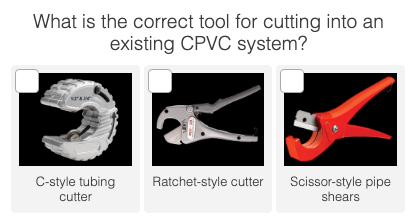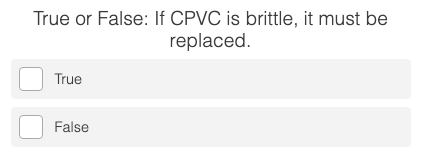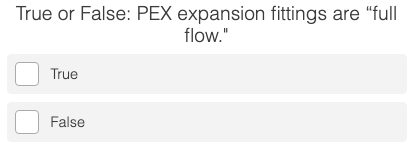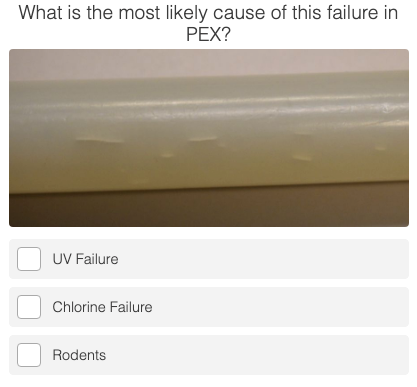
By: Jonathan Simon on August 26th, 2020
Test Your Service Plumbing Knowledge: Takeaways from Our Quiz
PEX | Service Plumbers | CPVC
Did you know that more than than 60% of plumbers don’t know the correct tool to service CPVC? Early this year, we launched a short quiz to gauge plumbers’ knowledge of plumbing material characteristics and the right tools to use with different materials. More than 1,500 plumbers took the quiz, and the results were truly surprising.
Before we review the results, if you’d like to take the quiz and see how you stack up before reading the answers, you can do so here.
Servicing CPVC
The question that received the highest percentage of wrong answers involved the right tool to use when servicing CPVC. Of the three choices presented, only 36% of participants chose the correct answer: C-style tubing cutters.
 The top response to this question was ratchet-style cutters at 41%. Ratchet-style cutters are used for installing new CPVC, but as CPVC ages it becomes more rigid. When this happens, the pressure-bearing capability of the pipe actually increases, making it stronger than it was originally. But the tool used to cut it needs to change. Using C-style cutters on aged CPVC helps prevent cracking.
The top response to this question was ratchet-style cutters at 41%. Ratchet-style cutters are used for installing new CPVC, but as CPVC ages it becomes more rigid. When this happens, the pressure-bearing capability of the pipe actually increases, making it stronger than it was originally. But the tool used to cut it needs to change. Using C-style cutters on aged CPVC helps prevent cracking.
Even more surprising, was that 23% of plumbers chose the scissor-style pipe shears, which are intended only for flexible hose and tube and should never be used to cut into a rigid pipe material like CPVC.
A related question asked if “brittle” CPVC needs to be replaced. More than half of participants (59%) underestimated the performance of CPVC and answered true to this question. In fact, as mentioned previously, older CPVC may be less flexible but continues to have excellent pressure-bearing capability and can remain in service.

Participants did well when asked to select the proper dauber size to use for CPVC solvent welds. Seventy percent knew that a dauber half the diameter of the pipe is best for providing an even coat of solvent.
These knowledge gaps show a need for plumbers to continue to seek training and education about the recommended procedures for servicing CPVC. In fact, by taking some of the actions indicated by these common incorrect answers, plumbers may be actually creating more problems for themselves and their customers. To help plumbers access training and education on servicing CPVC, we’ve created a new information hub on our website to make it easier for plumbers to access resources on servicing CPVC.
Servicing PEX
The quiz exposed a lack of awareness of the effect of PEX fittings on flow rates with 48% of participants agreeing with the false statement that PEX expansion fittings are “full flow.”

This confusion may result from marketing by PEX manufacturers that labels some expansion fittings as “full flow” even though the nature of PEX fittings doesn’t make this possible. With all PEX fittings, the pipe fits around the outside of the fitting, reducing the internal diameter within the fitting and restricting flow.
Participants also struggled to identify the cause of a relatively common PEX failure illustrated in the photograph below. Forty-two percent attributed this failure to UV light while it actually shows a classic case of chlorine failure. The confusion here is somewhat understandable because UV light is a concern with PEX and can contribute to chlorine-related failures.
 However, UV light doesn’t actually cause this failure. What it does is act as a strong catalyst for the oxidation process that consumes the chlorine-inhibiting anti-oxidants that protect the pipe from chlorine induced oxidation. As these chlorine inhibitors get consumed, piping is left vulnerable to attack from chlorine in the water.
However, UV light doesn’t actually cause this failure. What it does is act as a strong catalyst for the oxidation process that consumes the chlorine-inhibiting anti-oxidants that protect the pipe from chlorine induced oxidation. As these chlorine inhibitors get consumed, piping is left vulnerable to attack from chlorine in the water.
It’s clear that a significant percentage of plumbers may be underestimating the true cost of working with PEX in terms of higher chlorine sensitivity and reduced flow rates within residential plumbing systems.
Stay on Top of Your Game
Our Proper Pipe Handling Quiz had two objectives. First, it was intended to be a fun way for plumbers to test their knowledge of working with CPVC and PEX. If you took the quiz, we hope you enjoyed it and maybe learned something in the process.
The quiz also helped shine a light onto the issue’s plumbers may be having servicing these materials. One key issue that emerged was correct tool usage when servicing CPVC.
Plumbers will have a much easier time servicing CPVC using C-style cutters. As we continue to spread the word about this simple solution to a problem that has frustrated some plumbers, we ask you to help share this information with your fellow plumbers. For more insights and tips on servicing CPVC visit flowguardgold.com/servicesuccess.




